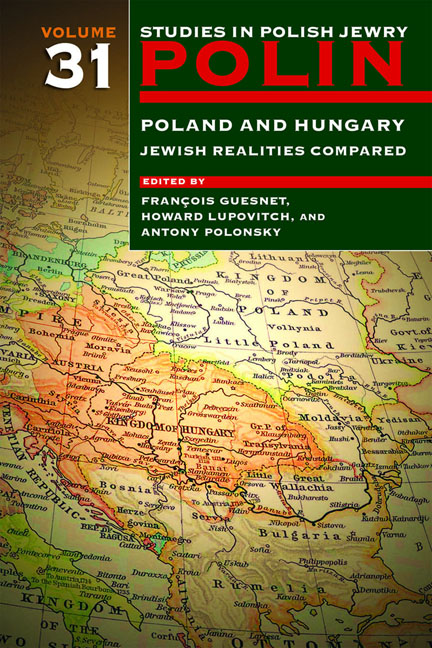Book contents
- Frontmatter
- Dedication
- Editors and Advisers
- Preface
- Polin
- Polin: Studies in Polish Jewry
- Contents
- Note on Place Names
- Note on Transliteration
- Part I POLAND AND HUNGARY: JEWISH REALITIES COMPARED
- JEWISH ACCULTURATION AND INTEGRATION
- JEWISH RELIGIOUS LIFE
- JEWS IN POPULAR CULTURE
- THE INTERWAR YEARS
- THE HOLOCAUST AND ITS AFTERMATH
- PERSONAL REFLECTIONS
- Part II NEW VIEWS
- Part III OBITUARIES
- Notes on the Contributors
- Index
Polish and Hungarian Jews: So Different, Yet So Interconnected: An Interview With István Deák
- Frontmatter
- Dedication
- Editors and Advisers
- Preface
- Polin
- Polin: Studies in Polish Jewry
- Contents
- Note on Place Names
- Note on Transliteration
- Part I POLAND AND HUNGARY: JEWISH REALITIES COMPARED
- JEWISH ACCULTURATION AND INTEGRATION
- JEWISH RELIGIOUS LIFE
- JEWS IN POPULAR CULTURE
- THE INTERWAR YEARS
- THE HOLOCAUST AND ITS AFTERMATH
- PERSONAL REFLECTIONS
- Part II NEW VIEWS
- Part III OBITUARIES
- Notes on the Contributors
- Index
Summary
HL: There have been many more students writing about Poland than Hungary, or certainly about Polish Jews than Hungarian Jews. Why do you think this is? Especially with respect to American students, why are so many more drawn to Polish Jewry, or Russian Jewry, or Soviet Jewry, or … than are drawn to Hungarian Jewry?
ID: There are several reasons, or so I believe. First, the great majority of American Jews are of Polish, Lithuanian, or Russian origin. Relatively few (though still many) are from Hungary. Second, the tragedy of Polish Jewry is better known; therefore, when people talk about the Holocaust, they mean Poland, even though many were killed who were not Polish Jews. The Hungarian Holocaust became widely known later, only in the last few decades.
Another reason is that Polish Jews were not as assimilated as many Hungarian Jews were. Consequently, when Polish Jews talked about what had happened to them they spoke more often about Poles as the ones who had participated in their persecution. Rightly or wrongly, the Polish Jews furthered the notion that Poles—the non-Jewish Poles—were enemies and persecutors who assisted the Germans in killing them. This created much controversy after the war, because the Poles mainly saw themselves as martyrs and heroic resisters.
The Hungarian situation was very different, because the Hungarian Jews’ relationship with the Hungarians was much more controversial, much more complicated, and so many Jews did not want to admit that most Hungarians had been antagonistic to them. For an assimilated Hungarian Jew—and many, many were assimilated—it was a very painful thing to talk about. Hl: Yours was a family of assimilated Hungarian Jews?
ID: My family was among the most assimilated, I would say, because they had converted, although not all of them. I did not have a single relative, except for my grandparents, who had not converted.
HL: It was your parents or grandparents who converted before the war?
ID: Well, not my grandparents. My grandfather did not convert. When I attended his funeral in 1940—he was 88 when he died—I did not understand the ceremony. I was 14.
- Type
- Chapter
- Information
- Polin: Studies in Polish Jewry Volume 31Poland and Hungary: Jewish Realities Compared, pp. 503 - 512Publisher: Liverpool University PressPrint publication year: 2018



